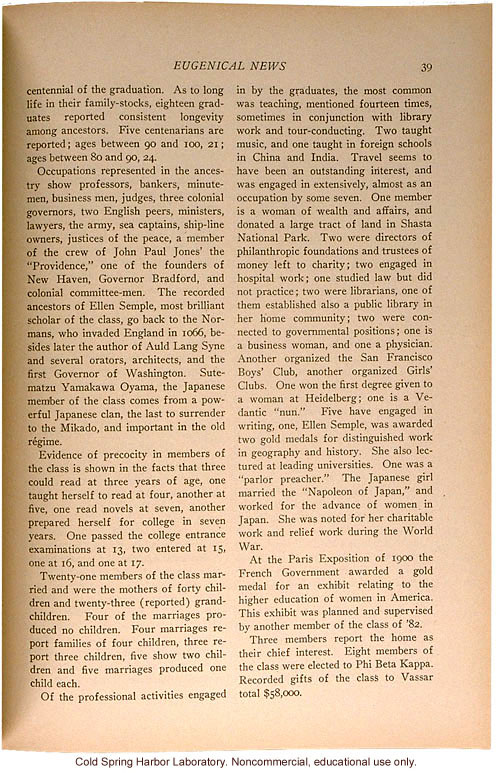Eugenical News 39
centennial of the graduation. As to long life in their family-stocks, eighteen graduates reported consistent longevity among ancestors. Five centenarians are reported; ages between 90 and 100, 21; ages between 80 and 90, 24.
Occupations represented in the ancestry show professors, bankers, minute-men, business men, judges, three colonial governors, two English peers, ministers, lawyers, the army, sea captains, ship-line owners, justices of the peace, a member of the crew of John Paul Jones' the "Providence," one of the founders of New Haven, Governor Bradford, and colonial committee-men. The recorded ancestors of Ellen Semple, most brilliant scholar of the class, go back to the Normans, who invaded England in 1066, besides later the author of Auld Lang Syne and several orators, architects, and the first Governor of Washington. Sutematzu Yamakawa Oyama, the Japanese member of the class comes from a powerful Japanese clan, the last to surrender to the Mikado, and important in the old regime.
Evidence of precocity in members of the class is shown in the facts that three could read at three years of age, one taught herself to read at four, another at five, one read novels at seven, another prepared herself for college in seven years. One passed the college entrance examinations at 13, two entered at 15, one at 16, and one at 17.
Twenty-one members of the class married and were the mothers of forty children and twenty-three (reported) grandchildren. Four of the marriages produced no children. Four marriages report families of four children, three report three children, five show two children and five marriages produced one child each.
Of the professional activities engaged in by the graduates, the most common was teaching, mentioned fourteen times, sometimes in conjunction with library work and tour-conducting. Two taught music, and one taught in foreign schools in China and India. Travel seems to have been an outstanding interest, and was engaged in extensively, almost as an occupation by some seven. One member is a woman of wealth and affairs, and donated a large tract of land in Shasta National Park. Two were directors of philanthropic foundations and trustees of money left to charity; tow engaged in hospital work; one studied law but did not practice; two were librarians, one of them established also a public library in her home community; two were connected to governmental positions; one is a business woman, and one a physician. Another organized the San Francisco Boys' Club, another organized Girls' Clubs. One won the first degree given to a woman at Heidelberg; one is a Vedantic "nun." Five have engaged in writing, one, Ellen Semple, was awarded two gold medals for distinguished work in geography and history. She also lectured at leading universities. One was a "parlor preacher." The Japanese girl married the "Napolean of Japan," and worked for the advance of women in Japan. She was noted for her charitable work and relief work during the World War.
At the Paris Exposition of 1900 the French Government awarded a gold medal for an exhibit relating to the higher education of women in America. This exhibit was planned and supervised by another member of the class of '82.
Three members report the home as their chief interest. Eight members of the class were elected to Phi Beta Kappa. Recorded gifts of the class of Vassar total $58,000.
[end]


